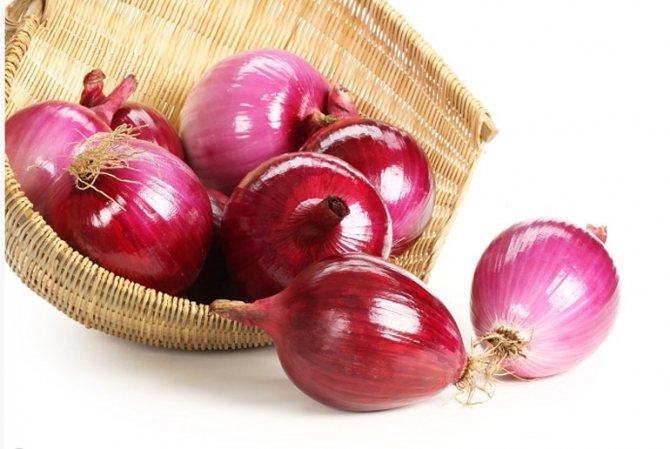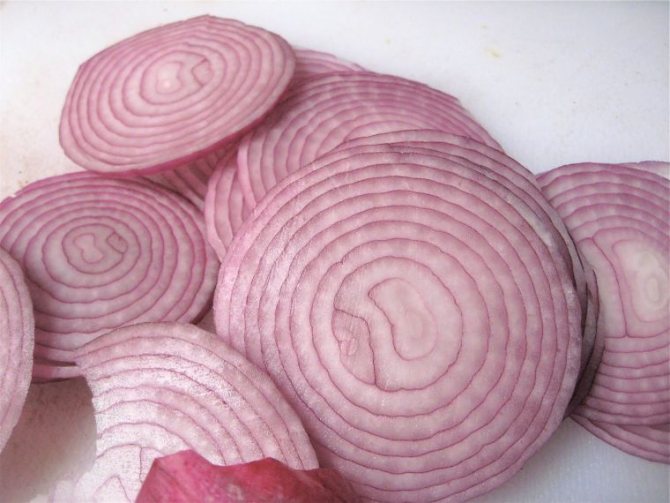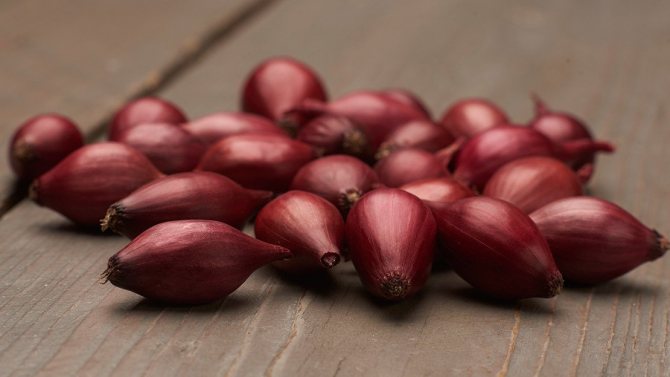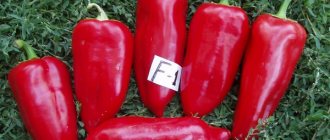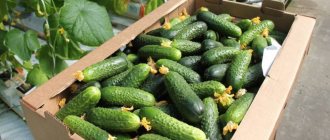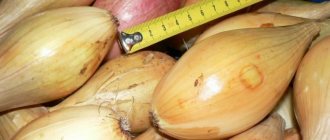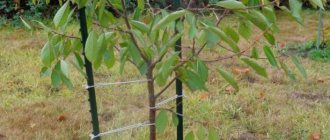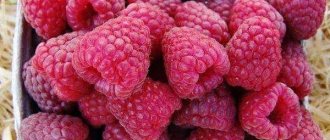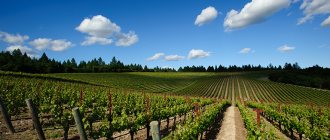Bow Red Baron description of the variety, planting and care, photos, reviews, advantages and disadvantages which are described in this article, is distinguished by its exquisite taste and special benefits. Red onions contain 2 times more antioxidants than regular onions. Red (purple) onions help get rid of bad cholesterol.
Depending on the region of cultivation and the nutritional value of the soil, the amount of vitamins and minerals in the onion will be different. The most useful are the top juicy flakes. The Red Baron onion variety is considered one of the best among the red varieties. Next, you can study its characteristics, advantages and disadvantages, as well as the characteristics of cultivation.
Description of the variety
The culture ripens in about 90-100 days. The root system is strong and well developed, thanks to which this onion can grow successfully even during drought. The onion grows with a mass of 50-150 g, the maximum weight is 200 g. The onion has a rounded shape, slightly flattened in the area of the tail and rhizome. The color of the onion is burgundy with a purple tint. The scales are dense, reddish-purple, tightly attached to the head, which helps the onion to be stored much longer.

Onion color burgundy with purple tint
The feathers of the Red Baron onion are dark green, with a slight waxy bloom. The taste of the bulb and feathers is without bitterness, slightly pungent. Solids in the composition of 13.3%.
Cleaning and storage
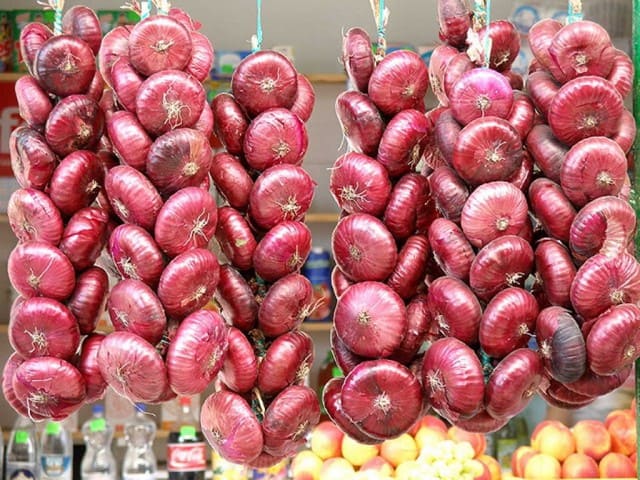

The Red Baron is cleaned in August. First, cleaning is carried out selectively, paying attention to the neck. The crop should be completely dry during the ripening period. It is important to harvest the entire crop before the start of the rainy season. To do this, the onions are dug with a pitchfork, the neck is cut off, leaving only 10 cm. The dug out bulbs are left to dry in the beds or in another open place for 2 weeks. All bulbs are laid out in a thin layer so that they dry well under the sun and wind.
During this period, not only the fruits will dry well, but also sick and rotten bulbs will become noticeable. They are discarded. Then the onions are sorted out and stored in a permanent place. They can be braided or stacked in boxes and nets.
Characteristics of Red Baron onions
Check out these articles as well
- Geese breed Legart
- Rex Rabbits
- Why chickens lay small eggs
- Pear variety Forest Beauty
The Red Baron onion variety is popular with farmers. It not only grows quickly, but also tastes good. And what characteristics are inherent in it?
- Short ripening period.
- Unpretentiousness to the ground.
- Resistance to diseases (downy mildew, root rot, fusarium) and pest attacks.
- Commodity quality and transportability.
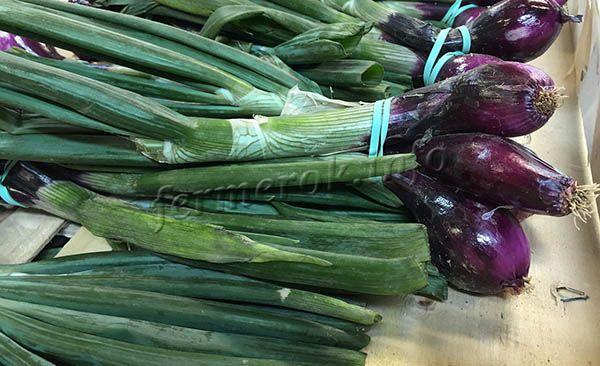

The feathers of the Red Baron onion are dark green, with a light waxy bloom
- Productivity from a square of plantings up to 3 kg. With 500 g of sevka, an average of 10-15 kg of large heads are obtained.
- Onions can be stored well until spring without losing their taste.
Interesting!
The main disadvantage of the variety is that you have to buy seeds every year, because it is very difficult to grow them.
Varietal characteristics
Red onion Red Baron belongs to the group of early maturing varieties. This medium-early onion variety is most commonly used in hobby farming, but is also great for commercial cultivation. It is unpretentious, therefore it is suitable for inexperienced vegetable growers.
| Name | The main characteristics of the variety |
| Appointment | universal |
| Ripening period | 80-100 days, harvest usually begins in the second half of July |
| Average yield | 150 kg / ha (150 kg per one hundred square meters) |
| Features of the variety |
|
| Requirements for soil, planting site |
|
| Frost resistance | Cold hardy, but not frost resistant. Outdoors, it can withstand temperature drops of up to 2-3 degrees Celsius. |
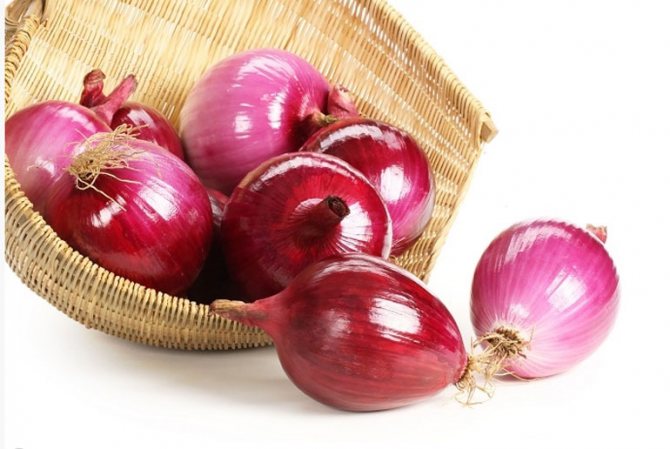

Cultivation regions
The variety is included in the State Register for the Central Black Earth Region. This means that it is allowed for cultivation in areas:
- Central,
- Central Black Earth,
- Volgo-Vyatsky,
- North Caucasian,
- Ural.
Description of bulbs
As the name suggests, Red Baron is a variety of red onions. Its outer dry scales are purple-red, the inner juicy ones are dark red in color.
Bulb characteristics:
- aligned;
- rounded, flattened;
- with an average weight of 50-120 grams;
- scales, tight-fitting, difficult to separate;
- juicy;
- mild taste.
The bulb contains:
- sugars - 8.8%;
- vitamin C - 17-28 mg% (depending on growing conditions);
- quite a lot of flavonoids - 119.75 mg%.
With proper agricultural technology, the bulbs are stored well.
In cooking, it is recommended for fresh salads, has a mild taste. Used in meat dishes, sauces, fillings.


Advantages and disadvantages
Advantages of the variety:
- versatility of use;
- excellent taste characteristics;
- high yield rates;
- the possibility of growing in various climatic zones.
There were no significant shortcomings in the variety.
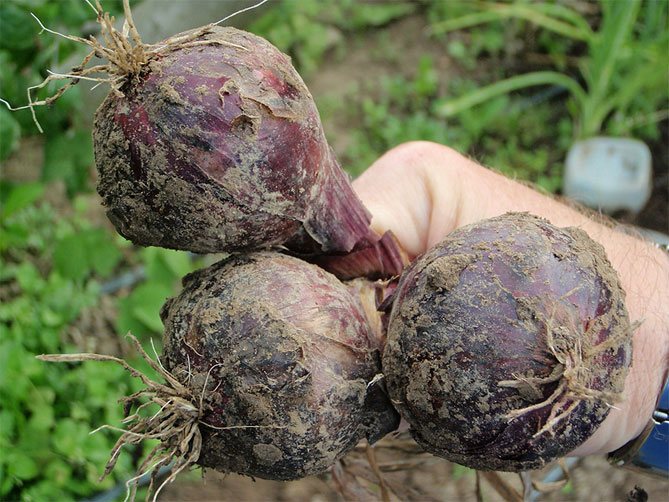

Features of sowing onion seeds
The planting bed is prepared in advance. It is best to choose a place where there is a lot of light and the land is not swampy. During digging, peat is added to the soil. You need about 2 buckets of peat per square meter. You can also add a glass of wood ash and half a bucket of humus. Fertilizer is applied to the site 2 weeks before planting seed or sowing seeds.
Planting is carried out by seeds or sowing. Sevok is grown from seeds in the first year. And in the second year, it is planted to obtain large onion heads. However, in the southern regions, large onion heads can be grown from seeds in a year. This result is achieved due to the short ripening period of the Red Baron.
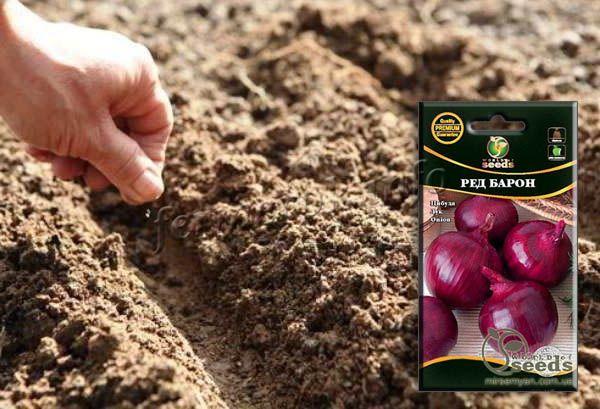

Features of sowing Red Baron onions with seeds
Interesting!
If the onion will be grown for feathers, while digging the ground for planting, you must add 1 tablespoon of potassium nitrate to it. And when you need to get large bulbs, the same amount of superphosphate is added to the ground.
Before sowing, the seeds are quenched in water (+ 50 ... + 60 degrees), then they are placed in the refrigerator for a day. An hour before sowing, the seeds are treated with a weak solution of potassium permanganate and, if desired, sprayed with the Epin growth stimulator. It remains only to dry the seeds, and you can use them for sowing.
Sowing of seeds is carried out at the end of April, when return frosts will pass. Ditches up to 1.5 cm deep are made on the garden bed. The permissible distance between the rows is 15 cm. After that, the ground is watered and the seeds are sown at a distance of 1-1.5 cm. When the seeds are laid out, they are sprinkled with earth and covered with a film so that the seedlings appear earlier. The first shoots can be seen in 2-3 weeks.
Features of agricultural technology
Growing Red Baron onions is possible from seeds and sets. The choice of method depends on the conditions.
From sevka
Red Baron onion sets are planted in late April and early May.For planting, select areas with fertile sandy loam and light loam. In the fall, on poor soils, humus or compost is preliminarily introduced. In the absence of organic matter, superphosphate and potassium chloride are used. The best predecessors of onions:
- cabbage,
- cucumbers,
- tomatoes.
The culture is returned to its original place no earlier than 3-5 years.
Attention! So that the onion does not go into the arrow, the sets must be stored at low positive temperatures.
If mistakes are made in the storage mode, before planting, the onions are heated for 2 weeks at a temperature of about +30 ° C.
To accelerate germination, the necks of the bulbs are carefully cut without touching the growth point. Then the planting material is soaked overnight in warm water. Sevka is planted to a depth of 3-4 cm.
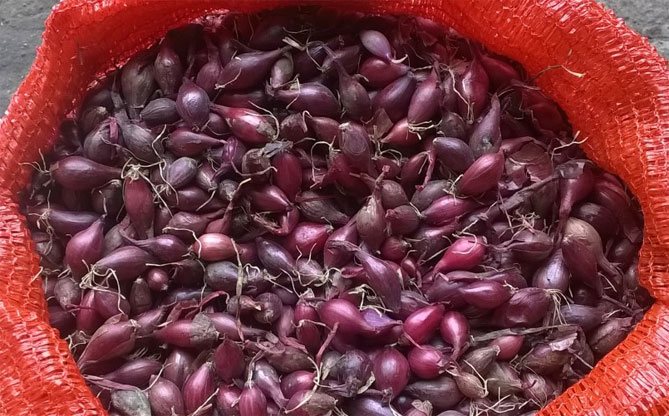

It is most convenient to disembark with belts. The distance between the bulbs should be at least 5-7 cm, between the lines about 20 cm.
Further onion care consists in the timely removal of weeds, weeding, watering. In dry years, the onions are watered weekly before the tops start lodging. After that, watering is stopped completely.


As soon as the aboveground part turns yellow and grows light, they begin harvesting. Bulbs are selected from the soil, laid out in the shade of awnings for further drying.


From seed
Many novice summer residents are interested in learning how to grow onions from seeds. From the advantages of this method, it should be noted the complete absence of arrows and low costs for planting material, from the disadvantages - rather high labor costs and a longer growing period. Subject to agricultural technology, the yield remains at the same level.
Attention! Onion seeds do not germinate well, so they are pre-soaked.
For soaking, use a light pink solution of potassium permanganate. The planting material is kept in the solution for a day. Then the seeds are washed with clean water, laid out on a damp cloth for germination. After pecking, the seeds are sown in pre-prepared boxes with a loose, nutritious substrate to a depth of about 1 cm.
To determine exactly when to plant seeds, you need to take into account the climatic conditions of each specific region. For example:
- for the middle lane, the optimal time is the first half of February,
- in the south - January.
When the seedlings reach a height of 3-4 cm, they dive into separate cups. A week later, the seedlings are fed with full mineral fertilizer. By the time of planting in open ground, the seedlings should be 5-7 cm high. In the future, the agricultural technology of onion planted with seeds does not differ from growing from seedlings.
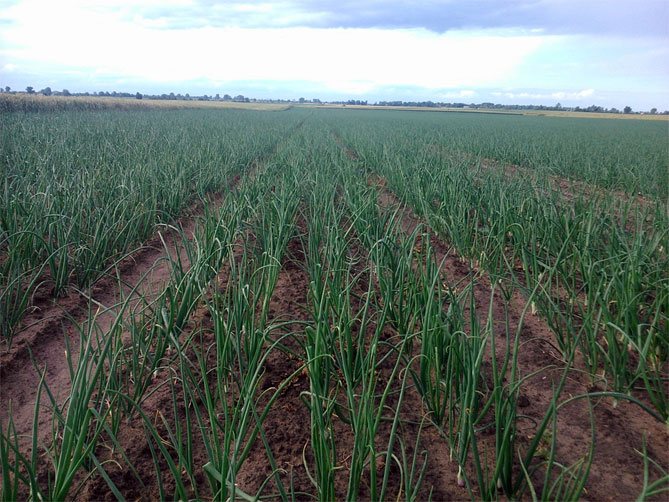

Planting onion sets Red Baron
We recommend reading our other articles
- Tersk horse breed
- Turkey feed
- When to dig tulips
- Description of the breed Peking duck
Most often, Red Baron onions are grown from sets. It's much faster, easier. Sevok can be bought at a specialty store. 3-4 days before planting, the sets are sorted (by size) and sorted to exclude any damaged or diseased bulbs. Then the onion must be soaked for 12-15 hours in water (+ 35 ... + 40 degrees). If desired, you can soak it in a solution of potassium permanganate for 1 hour. Before planting, it is necessary to dry the sevok so that the scales are dry.


Planting onion sets Red Baron
Planting onion sets is carried out when the temperature on the street is set at + 10 ... + 15 degrees. If you plant the sets later, the final harvest may be bitter and not very juicy. If you plant the onions ahead of time, it will give a lot of greens, but the onion itself will be small.
Planting ditches are made to the required length. The depth of the grooves is 3-4 cm, the distance between the rows is 20 cm. The sevok is planted with a distance of 8-10 cm, so that it was possible to develop the head in the ground. After planting the sevka, it is covered with earth and watered.
Interesting!
Red Baron onions are high in ascorbic acid and antioxidants. It is good for cooking and does not burn the eyes much while cleaning, cutting.
Protection from pests and diseases
In some unfavorable years, the Red Baron varietal onion can suffer from a number of pests and diseases. Up to 90% of the crop may be affected.
Onion fly
The most common pest of onions. Onion fly is a small insect 6-7 mm in size, dark in color with a characteristic yellow stripe on the back. The fly feeds on nectar, the larvae actively damage the bulbs. Within 10-15 days after departure, the onion fly lays eggs, from which colorless larvae 1 cm in size hatch.
In the process of feeding, the larvae damage the bottom and scales of the bulbs, leading to decay. The period of development of individuals does not exceed 3 weeks, then they pupate. The pupae themselves, dark brown in color, overwinter in the soil and plant debris, then the development cycle is repeated. Under favorable conditions, the onion fly gives 2 generations in one season.
The easiest way to deal with an onion fly is to create shelters. Onion beds are tightly covered with a layer of non-woven fabric. When choosing a covering method, the location of the landings must be changed annually.
Insecticides are most effective against flies. For example, you can use:
- powder "Zemlin" - brought in at landing;
- granules "Mukhoed".
Onions grown with the correct use of these preparations fully comply with sanitary standards.
Onion hoverfly
Another dangerous pest of onions, garlic. Fly 5-6 mm long, bronze or green. The pest lays white eggs. The hatching larvae feed on the juicy parts of the bulbs. In severe infestation, larvae can be found at the base of the leaves. Damaged bulbs dry out or rot.
Onion hoverflies hibernate in soil and plant debris. The mass flight of flies occurs in late spring - early summer. Females lay their eggs directly on the bulbs or in the soil. The larvae hatch within 2 weeks and penetrate the bulbs. The development cycle lasts 3-4 weeks. The control measures for the onion hoverfly are similar to those for the onion fly.
White rot of the bottom
A widespread fungal disease. It affects the roots, bottom, scales of young bulbs. Infected plants die very quickly. Dying off begins from the tips of the leaves, then the whole plant gradually dries up. You can identify white rot by the characteristic fluffy bloom of white on the bottom of the bulb.
The main sources of infection:
- untreated planting material,
- the soil.
The most widespread outbreaks of white rot are observed at moderate temperatures combined with high air humidity.
To prevent the spread of rot, the recommended crop rotation must be strictly observed. It is also recommended to use fungicides:
- Ordan,
- Raek,
- other copper preparations.
Red Baron is one of the most popular red onions. The vegetable is valued for its large bulbs, which are distinguished by a relatively mild taste and aroma. Onions are suitable for long-term storage, they are characterized by a certain resistance to diseases. The variety is unpretentious, although it may require additional watering during a drought. It is not difficult to grow it on the site. The main thing is to adhere to the recommended agricultural techniques, not to neglect timely treatments for pests and diseases.
Onion care Red Baron
Growing Red Baron onions provides for several crop care procedures.
- Watering is carried out as the top layer of the earth dries up. This is usually done about 1-2 times a week, not more often.
- After watering, the earth is loosened so that it does not take on a dense crust. The same must be done after the rains.
- Weeds are pulled out as they emerge.
- If necessary, the onion is thinned out. This applies primarily to seed plantings, because the seeds are usually sown thickly.If sevok was planted, and at the proper distance from each other, then thinning is not required.


After watering, the earth is loosened
- Treatment for diseases is carried out at the beginning of the season and in summer if the onion is sick. If you don't want to use chemicals, you can use folk recipes - herbal infusions, wood ash, a mixture of sand and naphthalene.
- Cultivation also provides for timely feeding. When 3 feathers appear, you can add a mullein solution diluted with water in a ratio of 1:15 or superphosphate (1 tablespoon per bucket of water). Then, every 2-3 weeks, top dressing is made with potassium sulfate (1.5 tbsp. L / 10 l of water) or the same superphosphate (1 tbsp / 10 l of water). From the middle of July, top dressing can no longer be applied, so as not to harm the root crop!
Important!
Frequent watering can lead to the development of rot in the ground and the appearance of a wide variety of pests.
Growing and leaving seedlings in the open field
One of the ingredients for success in obtaining a high yield of onions is the correct selection of the site and its preparation.
Site selection and soil preparation
The onion area should be dry and sunny. Red Baron grows best where nightshades, legumes and cucumbers were previously grown. In the fall, the earth is dug up with a shovel half-bayonet and loosened. Then it is fertilized by introducing rotted manure (0.5 buckets per 1 m²), 2 buckets of peat, 1 tbsp. l. superphosphate. Wood ash can be added - 1 cup.
In the spring, when the snow melts, the area is sprinkled with ammonium nitrate, based on the instructions on the package.
Important! It is better to choose a site on a hill, since the proximity of groundwater is undesirable for onions.
The process of planting seedlings in the ground
On the prepared bed, holes are marked, the distance between which depends on the purpose of growing the onion:
- to obtain greenery between the pits, the distance is 10 cm;
- for a good harvest of the underground part, the distance is maintained at 15 cm.
If you need to get fresh greens, then the tops of the set are cut off with sharp scissors. Before planting, the garden bed is watered with water heated to + 50 ° C. Sevok is planted rather densely - this provides the best germination. When the bed is completely sown, the soil is slightly compacted with the addition of a thin layer of peat.
Watering
Red Baron onions need regular watering - in the first month, seedlings are watered 1-2 times a week from a watering can with very small holes. The water is heated in the sun up to + 30 ° С. Stop watering in mid-July. During this time, the bulbs mature and excess moisture can lead to rotting.
Loosening the soil and weeding
After each watering procedure, the soil is loosened to a depth of 3 cm to provide oxygen access to the roots. This is done very carefully, since the onion has a superficial root system. Weeding is carried out as the weeds grow.
We advise you to read about the properties of red onions.
Top dressing
This variety needs additional nutrition. When three feathers appear at the landings, you need to feed it with a mullein - 1 bucket of mullein for 15 buckets of water. Chicken manure is also suitable, but it is more saturated, and the norm will be 2 times less. Superphosphate is added to the solution - 1 tbsp. spoon on a bucket of fertilizer.
Subsequent feeding is done no earlier than 2-3 weeks - with potassium sulfate and superphosphate. Be sure to moisten the garden with water before applying any fertilizers. They stop feeding together with watering - in mid-July.
Collection and processing of onion harvest
Harvesting Red Baron onions begins in mid-August. By this time, the feather should already be yellow and lie on the ground. Onions are harvested in dry weather, then the harvest will be better stored. After the onion is dug out, it is laid out to dry for 2 days.
When the upper husk is dry, the roots and feathers are cut from the onion. Then it can be laid out to dry under a canopy or in a dry room for 15 days. During this time, the upper husk will completely dry out and the onion will become suitable for storage. They put it in bags, nets or store it in bundles - as it is convenient.
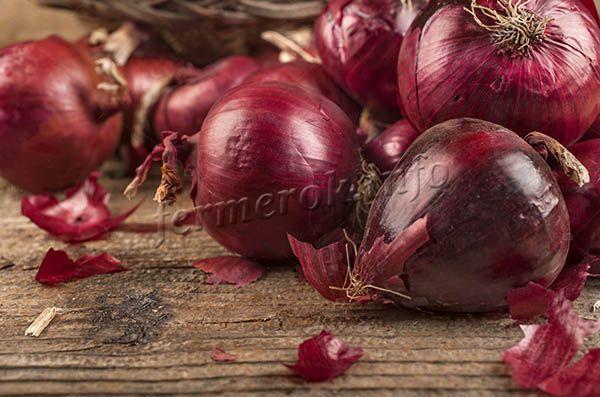

When the upper husk is dry, cut and dry under a canopy or in a dry room for 15 days
Red Baron onions are suitable for fresh consumption and processing. During frying, boiling, drying and even freezing, it does not lose its taste.
Interesting!
Despite its red color, Red Baron onions do not stain other ingredients of dishes, for which they are highly prized in cooking.
Advantages and disadvantages of the variety
Cucumber Baron
This "handsome" has practically no drawbacks. Unless, sometimes its seed material is difficult to find on sale. But this variety has many advantages. Its advantages include a high yield of the harvest, the universal purpose of fruits. The plant has increased resistance to root rot, peronospora and fusarium.
The bulbs have a balanced taste, combining sweetness, bitterness and pungency - due to this, any dish acquires spicy notes. Baron bears fruit well in any climatic zone. The turnips themselves look very attractive. The harvest is excellently stored in winter. Bundles of onions will decorate a rustic kitchen.
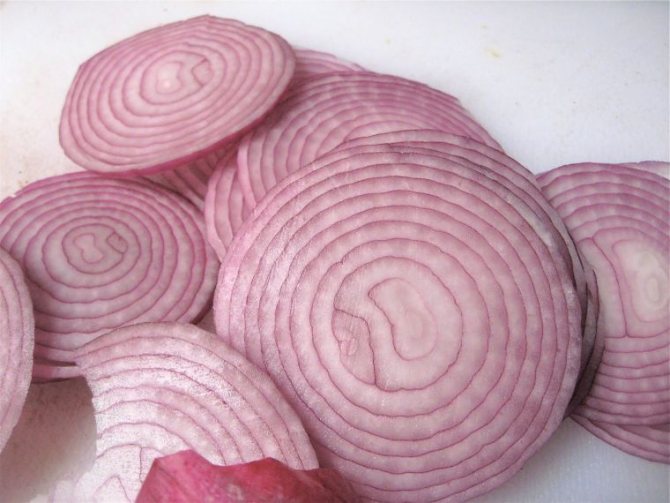

Red Baron's benefit
In addition, the Red Baron has health benefits. The use of a spicy vegetable activates metabolic processes in the body, lowers cholesterol levels, helps in the fight against colds, and is useful for patients with diabetes mellitus. The spicy vegetable is a powerful antiseptic, its juice is used to remove corns and treat certain skin diseases and gums.
On a note. Japanese scientists in the course of research have revealed the ability of red onions to reduce the risk of gastrointestinal cancer if consumed regularly.
Reviews of gardeners about the Red Baron onion
Gardeners' opinions on the Red Baron onion variety are presented below.
- Tikhon Sokolov: “We have been growing Red Baron onions with my wife for several years now. On our site every year, both sevok (from nigella) and large heads ripen. The variety is liked by its taste, color and the fact that it can grow in any conditions, the main thing is that there is enough sun. The bulbs are medium in size, easy to clean and store. It is not difficult to grow, the main thing is to feed it on time, otherwise the feather starts to turn yellow ahead of time ”.
- Angela Nikitina: “For the first time I tried to grow this onion with seeds more than 5 years ago. I grew a little onion, but very beautiful, good. Then I planted the set I had grown to get the head, and it also gave a good malformation. Since then I have been planting it annually. I don't grow much, because the family prefers white onions more, common, but for me there is no better Red Baron. It is neither spicy nor sweet - the perfect balance of flavor. "
- Andrey Vasiliev: “I used to plant mostly white onions, because I always thought that red ones were more capricious. But oddly enough, Red Baron is easy to grow, and he is not inferior to the taste of his white counterpart! The culture grows quickly, gives a large harvest and almost does not get sick. The latter especially pleases. Because I don't like chemical treatment and I avoid it to the last, as they say. As for the taste, the Red Baron is suitable for both salads and processing - a very good variety! ".
Time to board
The optimal time for disembarkation is stable weather, no night frosts. This usually happens in the last days of April or early, mid-May (southern and middle regions). In the northern strip - planting is done later, in the first days of June.
You can grow onions using seedlings. This is a cheaper method, but is associated with a lot of hassle in the process of preparing for disembarkation. The onion grown from seedlings does not give arrows, it allows you to get turnips in the same year. They persist poorly until spring, but are suitable for planting in the fall - before winter.
Disembarkation should be done at a temperature:
- Air: during the day 0 +5 ° С, at night - about -3 ° С.
- Soils: the ground should not be too warm up to +4 ° С
This is usually done in October, early November.The main thing is that the sevok should take root before the frost appears, and did not have time to shoot the green arrows.
Benefits of planting in the winter:


Ripe red baron onion
- Earlier aging.
- The bulb is less susceptible to various kinds of diseases.
- No need to waste time in the spring planting and caring for seedlings.
Negative factors include:
- Spring stagnation of water in the beds.
- Planting too deep and too early.
- Frequent changes in temperature. The bulb freezes and thaws several times.
Testimonials
Ulyana
I have been trying to grow this type of onion for a long time. We do not have sevka on sale, so I grew it with seeds. As a result, I achieved my goal. I raised Red Baron and I'm very happy about it. The bow is excellent. I really like its look and taste. It is great for salads and canning. Now in my garden the Baron is the most demanded and beloved one. It produces an excellent harvest and is very easy to care for.
Michael
I have been growing Red Baron for several years. I am just delighted with this variety. It has excellent taste and a long shelf life. It does not require any special care. I grow onions in large quantities. Everything suits me in this grade. I recommend everyone try growing Red Baron. He will not disappoint your expectations.



